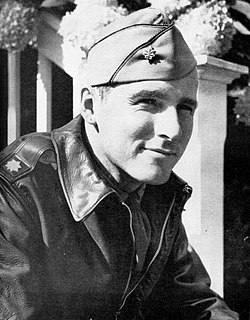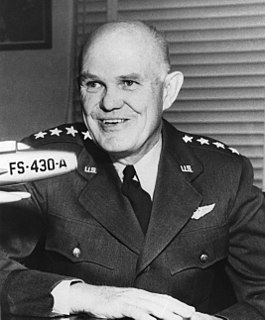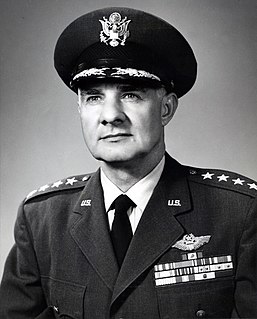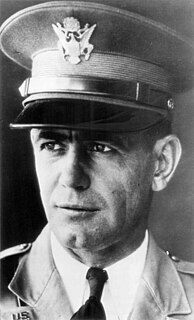
Carl Andrew Spaatz, nicknamed "Tooey", was an American World War II general. As commander of Strategic Air Forces in Europe in 1944, he successfully pressed for the bombing of the enemy's oil production facilities as a priority over other targets. He became Chief of Staff of the newly formed United States Air Force in 1947.

Gordon Aylesworth Blake was a lieutenant general in the United States Air Force who served as director of the National Security Agency from 1962 to 1965.
Ashley Chadbourne McKinley was an accomplished American aerial photographer and colonel in the U.S. Army Air Corps who helped pioneer aviation at subzero temperatures. He accompanied Richard E. Byrd as an aerial photographer on his expedition to the South Pole.

Fort Wainwright is a United States Army installation in Fairbanks, Alaska. Fort Wainwright is part of the Fairbanks North Star Borough and the coterminous Fairbanks Metropolitan Statistical Area. The installation is managed by U.S. Army Garrison Alaska and the senior command is 11th Airborne Division. Fort Wainwright was formerly known as Ladd Field (1939-1945) and Ladd Air Force Base (1947-1961); it was renamed Fort Wainwright in honor of General Jonathan M. Wainwright, a Medal of Honor recipient for his courageous leadership as commander of U.S. forces during the fall of the Philippines in World War II. Ladd Field was designated as a National Historic Landmark (NHL) on 4 February 1985 and Ladd Air Force Base was designated as Ladd Air Force Base Cold War District and was added to the National Register of Historic Places (NRHP) on the same day.

Lieutenant General Frank Maxwell Andrews was a senior officer of the United States Army and one of the founders of the United States Army Air Forces, which was later to become the United States Air Force. In leadership positions within the Army Air Corps, he succeeded in advancing progress toward a separate and independent Air Force where predecessors and allies such as Billy Mitchell had failed. Andrews was the first head of a centralized American air force and the first air officer to serve on the Army's general staff. In early 1943, he took the place of General Dwight D. Eisenhower as commander of all U.S. troops in the European Theater of Operations.

The Northwest Staging Route was a series of airstrips, airport and radio ranging stations built in Alberta, British Columbia, the Yukon and Alaska during World War II. It extended into the Soviet Union as the ALSIB.

Ladd Army Airfield is the military airfield located at Fort Wainwright in Fairbanks, Alaska. It was originally called Fairbanks Air Base, but was renamed Ladd Field on 1 December 1939, in honor of Major Arthur K. Ladd, a pilot in the U.S. Army Air Corps who died in a plane crash near Dale, South Carolina on 13 December 1935.

William Edwin Dyess was an officer of the United States Army Air Forces during World War II. He was captured after the Allied loss at the Battle of Bataan and endured the subsequent Bataan Death March. After a year in captivity, Dyess escaped and spent three months on the run before being evacuated from the Philippines by a U.S. submarine. Once back in the U.S., he recounted the story of his capture and imprisonment, providing the first widely published eye-witness account of the brutality of the death march. He returned to duty in the Army Air Forces, but was killed in a training accident months later.

General John Kenneth Cannon was a World War II Mediterranean combat commander and former chief of United States Air Forces in Europe for whom Cannon Air Force Base, Clovis, New Mexico, is named.

Frank Fort Everest was a United States Air Force general, and served as Commander, U.S. Air Forces in Europe, and Commander, Tactical Air Command.

Ennis Clement Whitehead was an early United States Army aviator and a United States Army Air Forces general during World War II. Whitehead joined the U. S. Army after the United States entered World War I in 1917. He trained as an aviator and served in France, where he was posted to the 3d Aviation Instruction Center and became a qualified test pilot. After the war, Whitehead returned to school at the University of Kansas. After he graduated, he was commissioned as a first lieutenant in 1920.

Paul Bernard Wurtsmith was a United States Army Air Forces general during World War II.

Harold Huston George was a general officer in the United States Army Air Forces during World War II. He began his military career before World War I when he enlisted as a private in the 3rd New York Infantry Regiment. Joining the Air Service, he became an ace in France in 1918, credited with five aerial victories.

Ralph Royce was a United States Army Air Forces general during World War II. A West Point graduate who learned to fly in 1915–16, he served with the 1st Aero Squadron in the Pancho Villa Expedition and later led it on the Western Front. During World War II as a brigadier general, he led the Royce special mission to Mindanao, in which a small force of bombers flew from Australia to attack Japanese targets in the Philippines. Later he was Deputy Commander of the Ninth Air Force and commanded the 1st Provisional Tactical Air Force.

United States Army Alaska was a military command of the United States Army located in the U.S. state of Alaska. A subordinate command of I Corps, USARAK was the ground element of the Alaskan Command. USARAK was headquartered at Joint Base Elmendorf-Richardson and commanded by a major general. USARAK was reflagged as the 11th Airborne Division on June 6, 2022.

Townsend Foster Dodd was the first commissioned US Army aviator. As a University of Illinois graduate with a Bachelor of Science in electrical engineering, he joined the Coast Artillery Corps and shortly thereafter became an aviator in the US Army Air Service. Dodd sat on many boards of review during the service's infancy and was one of the members who condemned pusher planes in favor of tractors. He served with General John Pershing on the Mexican Border where he set records for endurance flying. During World War I he was first assigned as the aviation officer of the American Expeditionary Force in 1917. He was later replaced by Colonel Billy Mitchell and was reassigned to the Bolling Mission.

George Benjamin Greene Jr. was an American Air Force major general who was commander of Lackland Military Training Center, Air Training Command, and Lackland Air Force Base, San Antonio, Texas. In the dual capacity he was responsible for the operation of one of the largest installations in the Air Force as well as for the direction of a wide range of training functions at the base.
Dale, South Carolina, is an unincorporated community and census-designated place (CDP) located in northern Beaufort County in the southern corner of the state of South Carolina, U.S.A. It was first listed as a CDP in the 2020 census with a population of 633.
 Major
Major 














